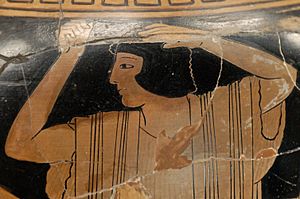Kleophrades Painter facts for kids
The Kleophrades Painter is the name given to an ancient Greek artist who painted vases. He was active in Athens from about 510 to 470 BC. His work is known for its beautiful style and is considered some of the best red-figure art.
Contents
Who Was the Kleophrades Painter?
This artist's real name is unknown. The name "Kleophrades Painter" was given to him in 1910 by a scholar named John Beazley. This name came from a potter's signature, Kleophrades, found on a cup.
For a short time, people thought his name was "Epiktetos II." This was because a vase called a pelike had the name Epiktetos on it. However, in 1981, another scholar, John Boardman, found that this signature was fake. So, the artist went back to being known as the "Kleophrades Painter."
It's believed that the Kleophrades Painter was the son of a potter named Amasis. He was also likely a student of another famous painter, Euthymides. His early paintings look a lot like his teacher's work. The Kleophrades Painter also had his own students, including the Berlin Painter. He is considered one of the greatest vase painters from the late Archaic period in Athens.
What Kinds of Vases Did He Paint?
The Kleophrades Painter created many different types of vases. He focused mostly on large vases. The most common shapes he painted were:
- Calyx kraters (used for mixing wine and water)
- Hydrias (used for carrying water)
- Panathenaic amphorae (prize vases for athletic games)
- Neck amphorae (storage jars)
Around 113 vases are directly linked to him. Most of his vases have been found in Italy, especially in a place called Vulci. This shows that many of his artworks were made to be sold and sent to other countries.
His Painting Style and Subjects
The Kleophrades Painter likely worked in a famous art studio called the "Pioneer workshop." This workshop included other well-known red-figure painters like Euphronios and Euthymides. Scholars believe Euthymides trained the Kleophrades Painter.
He might have started by learning black-figure painting. This is because his earliest vases have borders and patterns done in black-figure style. Later, he started using red-figure for these details. He also sometimes used the white ground technique, which was a special way of painting on a white background.
You can often recognize the Kleophrades Painter's work by how he drew faces. His figures often have long, thin eyes and strong chins. He also had a unique way of showing the inner details of the ear. His paintings are known for showing strong emotions.
He mostly painted in the red-figure style. However, he also created many Panathenaic amphorae, which were always done in black-figure. These amphorae were often given as prizes in the Panathenaic Games. You can tell his Panathenaic amphorae by:
- The winged horse Pegasus on Athena's shield.
- The way Athena's hair is shown.
- The position of the spear behind Athena's head.
His art is admired for its excellent drawing and for the strong, well-proportioned figures he created. Other artists, like the Boot Painter and the Troilos Painter, were influenced by his style. They may have even worked in the same studio.
Images for kids
Related pages
See also
 In Spanish: Pintor de Cleofrades para niños
In Spanish: Pintor de Cleofrades para niños



